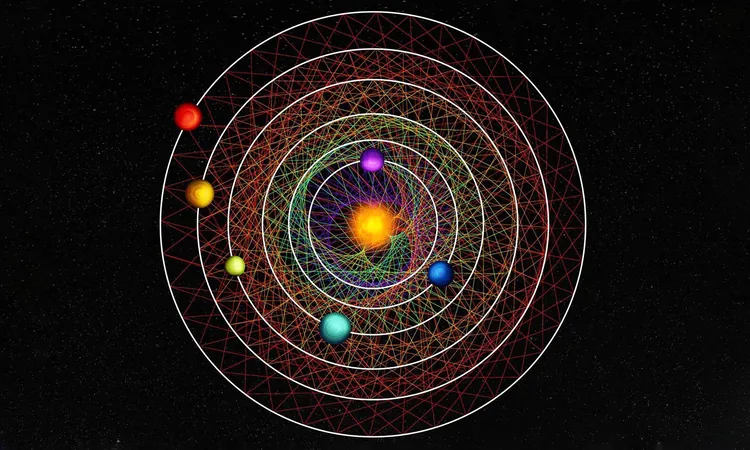
Astronomers Unearth a Breathtaking Six-Planet System: A Cosmic Dance of Resonance!
2025-01-12
Author: Kai
Discovery of the Six-Planet System HD110067
In a stunning revelation from the universe, researchers have discovered an extraordinary six-planet system orbiting a single star, showcasing an incredible mathematical harmony known as resonance. This captivating configuration, identified in the star system HD110067, is not just a rare find but a pivotal breakthrough for astronomers striving to understand planetary formation and stability.
Location and Characteristics of HD110067
Located about 100 light-years away in the northern constellation of Coma Berenices, HD110067 is home to six sub-Neptune planets whose orbits are locked in a synchronized dance, reminiscent of a perfectly tuned orchestra. Such resonance means that these planets maintain a specific and unchanging ratio to one another for millions, if not billions, of years. The rhythmic patterns observed among these planets hint at an intricate balance maintained over time, offering tantalizing insights into the gravitational influences that govern their interactions.
Detection and Confirmation
The initial signs of this intriguing planetary harmony came to light through NASA’s Transiting Exoplanet Survey Satellite (TESS), which detected unusual dips in the star's brightness—each suggesting a planet moving across its face. Subsequently, data from the European Space Agency’s CHaracterizing ExOPlanet Satellite (Cheops) confirmed the existence of this rare six-planet family.
Significance of the Discovery
Rafael Luque, from the University of Chicago and the leading figure in this study, emphasized the significance of this discovery: “This benchmark system will facilitate the understanding of sub-Neptunes—arguably the most common type of exoplanet—and their formation, evolutionary characteristics, material composition, and potential for hosting liquid water.”
Understanding Sub-Neptunes
Sub-Neptunes are particularly intriguing to scientists as they exist between Earth and Neptune in size, often exhibiting diverse compositions that range from thick gas envelopes to rocky surfaces. With many stars in our galaxy hosting these intermediate-sized planets, understanding their properties and conditions is crucial in the broader context of planetary science.
Formation and Stability of Resonant Systems
The formation of resonant systems like HD110067 occurs through a delicate interplay of gravitational nudges. However, such harmonies are precarious; disturbances from larger neighboring celestial bodies or random gravitational interactions can disrupt these exquisite orbits.
Rarity of Stable Multi-Planet Systems
Astronomers estimate only about one percent of multi-planet systems maintain such a stable formation over time. In the case of HD110067, the absence of larger planetary neighbors has likely played a crucial role in preserving this remarkable arrangement, allowing the six sub-Neptunes to thrive without disruptions.
Broader Implications of the Discovery
The implications of this discovery extend beyond understanding this particular system. Each new resonant configuration sheds light on the grand narrative of how planets form from dust and gas swirling in space. With ongoing studies, researchers intend to refine their measurements of the planets' masses and densities, which will further illuminate their internal structures and the potential for water retention on their surfaces—an essential element for understanding habitability.
Future Exploration and Questions
Excitingly, the discovery invites a plethora of questions about other planetary systems: How many additional resonant configurations are yet to be detected in our galaxy? What does this synchronization imply for the dynamics of planetary formation across different environments?
Publication and Future Research
The full details of this riveting research are published in the journal *Nature*, marking a significant milestone in the quest to unlock the secrets of our universe. As astronomers set their sights on HD110067 and similar systems, the future holds the promise of new revelations that could reshape our understanding of the cosmos.
Conclusion
The universe remains a mysterious place, and with every significant find, we inch closer to comprehending the intricate dance of celestial bodies that define our star-studded sky!


 Brasil (PT)
Brasil (PT)
 Canada (EN)
Canada (EN)
 Chile (ES)
Chile (ES)
 Česko (CS)
Česko (CS)
 대한민국 (KO)
대한민국 (KO)
 España (ES)
España (ES)
 France (FR)
France (FR)
 Hong Kong (EN)
Hong Kong (EN)
 Italia (IT)
Italia (IT)
 日本 (JA)
日本 (JA)
 Magyarország (HU)
Magyarország (HU)
 Norge (NO)
Norge (NO)
 Polska (PL)
Polska (PL)
 Schweiz (DE)
Schweiz (DE)
 Singapore (EN)
Singapore (EN)
 Sverige (SV)
Sverige (SV)
 Suomi (FI)
Suomi (FI)
 Türkiye (TR)
Türkiye (TR)
 الإمارات العربية المتحدة (AR)
الإمارات العربية المتحدة (AR)